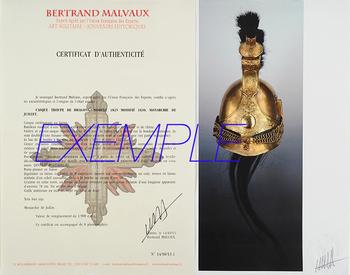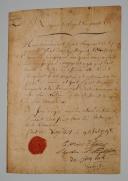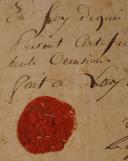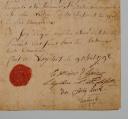
Émigrés. British Army. LOYAL EMIGRANTS REGIMENT, CERTIFICATE FOR FIDEL ARNAUD MAGUIEZ, volunteer in the Grenadier company, 9 April 1795. 18913-18
Sold out
Émigrés. English Army. LOYAL EMIGRANTS REGIMENT, CERTIFICATE FOR FIDEL ARNAUD MAGUIEZ, volunteer in the Grenadiers company, 9 April 1795. 18913-18
"We, commanding the said Regiment, certify that Mr. Fidel Arnaud MAGUIEZ, a volunteer in the Grenadiers Company, participated in the campaigns of 1793 and 1794, that he took part in all the actions of the said regiment, [...] he always behaved with honor and distinction, earning the esteem of his superiors and the regrets of his comrades.
In witness whereof, we have issued this certificate to him to be of value to him on all occasions.
Done at Loy(??) on 9th April 1795."
Four signatures including that of the Major and the Captain.
Remains of a red wax seal.
H 27.5 cm x 19.5 cm.
Fair condition, folds, stains and foxing, double page, manuscript on a single page.
NOTE:
The Loyal-Emigrant Regiment is a regiment of the Army of the Emigres.
Count Claude-Louis de La Châtre (born 1745 - died 1824) is an inspector of cavalry in Guyenne when he is elected as a deputy of the nobility of the bailiwick of Bourges (Berry) to the Estates-General. Emigrating in 1791, he campaigns in 1792 with the Bourbon army. Moving to England, he becomes the owner and colonel of the Loyal-Emigrant Regiment, participating in all campaigns of the emigres before becoming, in 1807, the representative of Louis XVIII to the King of England, and later a Minister of State and Duke.
It is at the beginning of 1793 that he undertakes the formation of his legion, which will be best known as the Loyal-Emigrant Regiment, funded by England. The unit has nearly 600 men in May (officers and gentlemen) and lands in Ostend on June 6, 1793. With significant reinforcements, particularly from many Flemish peasants, the corps grows to 1,060 men by the end of July. A portion of the regiment participates in the siege of Dunkirk in the army of Frederick, Duke of York and Albany, and distinguishes itself alongside the Rohan regiment.
During the capitulation of Valenciennes on July 28, 1793, an incident occurs that illustrates the goals of each side and the relationships between emigres and coalition forces. The city being occupied in the name of the Emperor of Austria, without any mention of the King of France or any regent. The emigres present refuse to attend the victory ball. The places are for those who take them, reply the Austrians.
La Châtre valiantly fights in October before retreating and regrouping in Bruges, where the ranks are replenished, particularly with the Carneville Free Corps. This unit is the former Normandy Legion of the Princes' army, commanded by the Count and Viscount of Carneville. It has been in the service of Austria since January 1, 1793, and has already rendered significant services.
On October 22, 1793, in front of the town of Menin defended by Hanoverians, half a battalion of the Loyal-Emigrant Regiment is annihilated in a deadly sortie at the Werwick mill. The action is intense. The emigres break through the Republican army occupying the streets of a long faubourg with swords and bayonets, overcoming all obstacles and even capturing two cannons. The Republicans are so confused by the surprise and the night, that after the passage of the small column, they mistakenly fire on each other. This small city is surrounded by 40,000 Republicans. Any resistance is impossible, but surrender is almost as futile, as the laws of the Convention forbid granting quarter to emigres. A survivor of the attack is guillotined, and a few days earlier, three soldiers of the regiment had been executed. Furthermore, the other battalion of the regiment was in Newport, and after the city surrendered a few days later, all the emigres who could not flee, around four-fifths, are shot.
Loyal-Emigrant sets up winter quarters in Menin after a retreat of the "carmagnoles", a nickname for Republicans. At that time, there is a high demand for enrollment in the emigre units. The regiment recruits many peasants from Flanders and Artois, Frenchmen leaving the Austrian units where they served until then (Lorrains or emigres reenlisted with the Emperor after '92), as well as blue deserters. Thirty men from the 5th Hussar Regiment defect to the Royalists, and there are also desertions in the 4th and 6th Hussar Regiments. Just at the beginning of 1794, 300 men are thus recruited. Religious persecution is at its peak, and many Catholics refuse to serve in a country where they guillotine the good Lord! The defected hussars are incorporated into the Loyal-Emigrant or the British Uhlans organized in September by Count Louis de Bouillé for the Duke of York and Albany. They are 300 to 400 former hussars from France in constant reconnaissance on the Belgian front.
After the retreat from Holland in the harsh winter of 1794 to 1795, the Loyal-Emigrant Regiment, which had always been in the most perilous front lines of the English army, settles into quarters in Hanover.
The Loyal-Emigrant Regiment is embarked and transported to the Isle of Wight, opposite Southampton, where the emigre landing at Quiberon is being prepared. This expedition includes barely 5,000 men, newly organized and unfortunately, almost exclusively composed of French prisoners of war in England. This recruitment conducted with threats, accepted by almost all reluctantly, becomes the main cause of the disaster of this too weak army.
After the failure of their landing, the regiments of Hervilly and Loyal-Emigrant withdraw in good order. The royalists show desperate bravery on this day. They had attacked with three thousand men the lines defended by fifteen thousand Republicans.
Alexandre Louis d’Allonville serves as an officer in the Loyal-Emigrant Regiment, surviving the different battles. The French emigre regiments paid by England are reorganized after the failure of the Quiberon landing (1795) and the disappearance of the Condé army (1799). Gradually, their initial mission - to liberate France from the revolution - is lost in the needs of English politics. The Loyal-Emigrant is directed towards Portugal in 1801 to support the Portuguese army on its borders. Veterans of this regiment and the Castries and Mortemart regiments are incorporated into the Company of Foreign Invalids on the Isle of Wight in 1798 and another at Lymington in 1801.
"We, commanding the said Regiment, certify that Mr. Fidel Arnaud MAGUIEZ, a volunteer in the Grenadiers Company, participated in the campaigns of 1793 and 1794, that he took part in all the actions of the said regiment, [...] he always behaved with honor and distinction, earning the esteem of his superiors and the regrets of his comrades.
In witness whereof, we have issued this certificate to him to be of value to him on all occasions.
Done at Loy(??) on 9th April 1795."
Four signatures including that of the Major and the Captain.
Remains of a red wax seal.
H 27.5 cm x 19.5 cm.
Fair condition, folds, stains and foxing, double page, manuscript on a single page.
NOTE:
The Loyal-Emigrant Regiment is a regiment of the Army of the Emigres.
Count Claude-Louis de La Châtre (born 1745 - died 1824) is an inspector of cavalry in Guyenne when he is elected as a deputy of the nobility of the bailiwick of Bourges (Berry) to the Estates-General. Emigrating in 1791, he campaigns in 1792 with the Bourbon army. Moving to England, he becomes the owner and colonel of the Loyal-Emigrant Regiment, participating in all campaigns of the emigres before becoming, in 1807, the representative of Louis XVIII to the King of England, and later a Minister of State and Duke.
It is at the beginning of 1793 that he undertakes the formation of his legion, which will be best known as the Loyal-Emigrant Regiment, funded by England. The unit has nearly 600 men in May (officers and gentlemen) and lands in Ostend on June 6, 1793. With significant reinforcements, particularly from many Flemish peasants, the corps grows to 1,060 men by the end of July. A portion of the regiment participates in the siege of Dunkirk in the army of Frederick, Duke of York and Albany, and distinguishes itself alongside the Rohan regiment.
During the capitulation of Valenciennes on July 28, 1793, an incident occurs that illustrates the goals of each side and the relationships between emigres and coalition forces. The city being occupied in the name of the Emperor of Austria, without any mention of the King of France or any regent. The emigres present refuse to attend the victory ball. The places are for those who take them, reply the Austrians.
La Châtre valiantly fights in October before retreating and regrouping in Bruges, where the ranks are replenished, particularly with the Carneville Free Corps. This unit is the former Normandy Legion of the Princes' army, commanded by the Count and Viscount of Carneville. It has been in the service of Austria since January 1, 1793, and has already rendered significant services.
On October 22, 1793, in front of the town of Menin defended by Hanoverians, half a battalion of the Loyal-Emigrant Regiment is annihilated in a deadly sortie at the Werwick mill. The action is intense. The emigres break through the Republican army occupying the streets of a long faubourg with swords and bayonets, overcoming all obstacles and even capturing two cannons. The Republicans are so confused by the surprise and the night, that after the passage of the small column, they mistakenly fire on each other. This small city is surrounded by 40,000 Republicans. Any resistance is impossible, but surrender is almost as futile, as the laws of the Convention forbid granting quarter to emigres. A survivor of the attack is guillotined, and a few days earlier, three soldiers of the regiment had been executed. Furthermore, the other battalion of the regiment was in Newport, and after the city surrendered a few days later, all the emigres who could not flee, around four-fifths, are shot.
Loyal-Emigrant sets up winter quarters in Menin after a retreat of the "carmagnoles", a nickname for Republicans. At that time, there is a high demand for enrollment in the emigre units. The regiment recruits many peasants from Flanders and Artois, Frenchmen leaving the Austrian units where they served until then (Lorrains or emigres reenlisted with the Emperor after '92), as well as blue deserters. Thirty men from the 5th Hussar Regiment defect to the Royalists, and there are also desertions in the 4th and 6th Hussar Regiments. Just at the beginning of 1794, 300 men are thus recruited. Religious persecution is at its peak, and many Catholics refuse to serve in a country where they guillotine the good Lord! The defected hussars are incorporated into the Loyal-Emigrant or the British Uhlans organized in September by Count Louis de Bouillé for the Duke of York and Albany. They are 300 to 400 former hussars from France in constant reconnaissance on the Belgian front.
After the retreat from Holland in the harsh winter of 1794 to 1795, the Loyal-Emigrant Regiment, which had always been in the most perilous front lines of the English army, settles into quarters in Hanover.
The Loyal-Emigrant Regiment is embarked and transported to the Isle of Wight, opposite Southampton, where the emigre landing at Quiberon is being prepared. This expedition includes barely 5,000 men, newly organized and unfortunately, almost exclusively composed of French prisoners of war in England. This recruitment conducted with threats, accepted by almost all reluctantly, becomes the main cause of the disaster of this too weak army.
After the failure of their landing, the regiments of Hervilly and Loyal-Emigrant withdraw in good order. The royalists show desperate bravery on this day. They had attacked with three thousand men the lines defended by fifteen thousand Republicans.
Alexandre Louis d’Allonville serves as an officer in the Loyal-Emigrant Regiment, surviving the different battles. The French emigre regiments paid by England are reorganized after the failure of the Quiberon landing (1795) and the disappearance of the Condé army (1799). Gradually, their initial mission - to liberate France from the revolution - is lost in the needs of English politics. The Loyal-Emigrant is directed towards Portugal in 1801 to support the Portuguese army on its borders. Veterans of this regiment and the Castries and Mortemart regiments are incorporated into the Company of Foreign Invalids on the Isle of Wight in 1798 and another at Lymington in 1801.
Reference :
18913-18

Next update Friday, april 4th at 1:30 PM
FOR ALL PURCHASES, PAYMENT IN MULTIPLE CHECKS POSSIBLE
bertrand.malvaux@wanadoo.fr 06 07 75 74 63
An authenticity certificate of the item including the description published on the site, the period, the sale price, accompanied by one or more color photographs is automatically provided for any item priced over 130 euros. Below this price, each certificate is charged 5 euros.
Only items sold by me are subject to an authenticity certificate, I do not provide any expert reports for items sold by third parties (colleagues or collectors).



